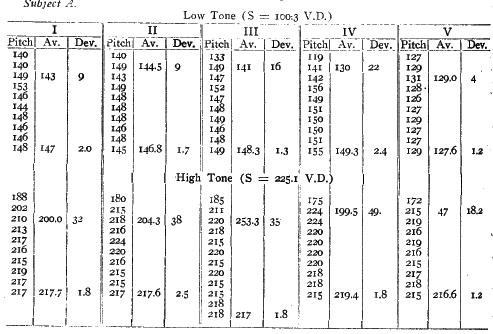
Originally published in Psychological Monographs, Volume 23(3), pages 159-180, 1917
Edward Herbert Cameron, Ph.D.
Assistant Professor of Education, Yale University
A study (1) of the effects of practice on singing tones at two different pitch levels near the upper and lower limits of the range of the male voice; and (2) of the relation of these activities to discrimination of tones. Practice in singing a tone of a certain pitch level resulted in improvement in accuracy of pitch of the tone in the cases of four out of six subjects. This improvement was not present in the singing of tones at a different level from that in which practice had taken place.
Practice in singing tones of a certain pitch was followed by improvement in discrimination of tones of the same pitch but no improvement in discrimination took place at the other pitch level. Improvement in the uniformity of the practiced sung tone was transferred to the other level.
Perhaps in no other sphere is the usual voluntary response to a sensory stimulus more precise and unvarying than in the reproduction of tones by singing. The vocal production of tones is, therefore, peculiarly adapted for the study of sensori-motor habits. While the sensory processes involved in such habits have been studied in detail, relatively little investigation has been made of the related motor processes. In a former paper the writer has shown some of the characteristics of sung tones and their changes under varying conditions of attention. Berlage (1) and Miles (7) have confirmed this work in some respects and expanded it in others.
The object of the investigation now presented was fourfold:
(1) To determine the relationship between ability to discriminate tones of a certain pitch and the ability to sing tones of the same pitch.
(2) To determine the changes which take place in the singing of tones of a certain pitch during the course of a long practice series.
(3) To determine what influence, if any, practice in singing of a certain pitch has on the ability to discriminate tones (a) of the same pitch and (b) of a different pitch.
(4) To determine what effect, if any, practice in singing tones of a certain pitch has on singing tones of a different pitch.
For carrying out such an investigation it is necessary to have (a) a means of testing sensory discrimination of tones of different pitch; (b) a means of recording the pitch of a sung tone.
The difficulties of a method for the former purpose are well-known. Seashore's report (10) recommends the use of standard tuning forks of slightly different pitches and appropriate resonators. This method was not used in the present instance because of difficulty in obtaining forks of the range of the human (male) voice, and because of certain advantages of manipulation to be gained by the method actually adopted.
In the method used the source of the tones, both for purposes of testing discrimination and for reproduction by singing, was electric tuning forks. Four such forks, two of approximately 100 v. d. and two of approximately 225 v. d. frequency were used. These forks were placed in circuit with a single telephone receiver of the watch case variety, which was placed in a room adjoining that in which the forks were placed. The prongs of one of each pair of forks were fitted with adjustable weights by means of which the pitch was varied above or below that of the other fork of the same range, the pitch of the latter being kept constant. The variations in pitch were measured indirectly by noting the position of the weights on a millimeter scale attached to the base at one side of the fork. To facilitate the reading of the position of the weights one of them was provided with a pointer which projected to a point just above the scale. The pitch for the various readings on the scale was ascertained by placing the forks in circuit with an electric marker recording on a smoked paper belt.
The telephone and forks were connected by means of a Pohl commutator, the cross bars at the base having been removed. The semi-circular rods were kept out of the mercury cups when at rest by a pair of springs attached to the base. When the switch was in this position the circuit to the telephone was interrupted. The current passed through the telephone and the standard fork when the free ends of the rods of the commutator were pressed in one direction, and through the telephone and variable fork when pressed in the opposite direction.
In the earlier investigation mentioned above there was used for the recording of sung tones a telephone receiver with mica diaphragm to which were attached magnifying levers. This method was discarded in the present investigation. A graphic record of the sung tone was obtained through the use of an ordinary voice key, similar to the Cattell model, but without any electro-magnetic attachment. The diaphragm is of very thin mica and is readily thrown into vibration by a tone sung into the air chamber. The voice key was placed in circuit with an electric marker of the Deprez pattern.
The sung tones were recorded on a long smoked paper belt running on two drums which were turned by hand. The time was recorded by an electric marker in circuit with a Kronecker interrupter regulated to intervals of 100 sigmas duration.
Before beginning the experiment the following preliminary tests were made:
(1) A test of the capacity of the telephone to register correctly the tone of the fork and respond to slight variations of tone. For this purpose recording levers were attached to the diaphragm of the telephone and the record thus obtained was compared with one obtained simultaneously from the fork through an electro-magnetic marker. There was no discoverable difference between the vibration rate of the fork and that of the telephone when recorded in this way.
(2) A similar test was made of the apparatus for recording the sung tones. A mica disk was attached to one of the prongs of the fork and placed in front of the air chamber of the voice key. In this manner records could be obtained of the vibration rate of the fork when transmitted through the voice key and comparison of these records with the records obtained at the same time through an electric marker showed no appreciable difference.
The tones obtained from the forks through the medium of the telephone were not pure tones and differed somewhat in quality, especially in the case of the pair of forks of lower pitch. The intensities of the tones of each pair of forks were apparently the same. The qualitative differences did not remain constant, but varied with differences of adjustment of the forks, especially differences in the distance of the adjustable button from the spring of the fork. In order to ensure the best possible adjustment, the experimenter made use of a second telephone which could be connected with the forks by means of a switch. In this way he could test the tones at will and introduce such variations in adjustment as to secure better tones, when necessary.
At best, however, the qualitative differences were nearly always sufficient to enable the observer to distinguish the two tones. Great precautions had, therefore, to be taken in the discrimination tests to make sure that the results were due to differences in pitch and not differences in quality. Furthermore, on these and other grounds, all claims that the results give an absolute pitch limen for the subjects tested must be abandoned. It was sought only to obtain a limen which should hold under the conditions of this experiment and which should serve as a basis of comparison between the various observers who were tested.
The subjects who took part in the investigation were as follows: Professor Angier and Dr. Frost of the Yale Psychological Laboratory; Dr. Metcalf, laboratory assistant; and Messrs. Reed, Molby and Avey, graduate students in psychology. These subjects will be referred to hereafter as A., F., M., R., My., and Ay. respectively. All of these subjects except A. are of average or slightly more than average musical ability. M. and R. have had some training in the use of musical instruments, while My. and Ay. have been trained in singing to a slightly greater degree than the average person. A. and F. have had no musical training whatever. F. sings only infrequently. A. belongs to that class of individuals who cannot "carry a tune" correctly, though his inability in this respect is not as marked as in many cases.
All six subjects were given a preliminary test (1) of discrimination of pitch at both the higher and lower levels; (2) of ability to reproduce, by singing, tones of both the higher and lower levels. Three of the subjects, A., F., and Ay., were then practiced for a long time in singing the higher tone; the other three subjects, M., R., and My., were practiced in the singing of the lower tone. After the practice in singing had stopped all subjects were re-tested as in the preliminary stage of the experiment.
In determining the capacity for pitch discrimination the following procedure was adopted. The observer sat in a partially darkened room with the telephone pressed lightly to the ear. A ready signal was given by means of a momentary flash of light from an electric lamp which was placed in front of the subject, but at some ten feet distance. A moment later the standard tone and the comparison tones were given for periods of two seconds each with a two second interval between them. The observer made known his judgment by pressing a key which was connected with a sound hammer in the experimenter's room. Judgments were classified as (1) same or doubtful; (2) higher; or (3) lower.
The pitch of the variable fork was varied by gradual steps below that of the standard fork and the threshold was regarded as having been reached at the point where the observer gave five correct judgments in succession. To avoid as far as possible unintentional judgments on the basis of the differences in quality of the two tones the standard tone was frequently given after the comparison tone. Furthermore, when it appeared that the threshold had been reached, the pitch of the variable fork was occasionally made higher instead of lower than that of the standard. In this way the experimenter could test whether the observer was meeting the requirements of the experiment by relying solely on differences of pitch in making his judgments. If it was found that this was not the case, as happened in several instances, the observer was cautioned and usually adopted a more critical attitude toward his judgments. Before recording any results in these experiments two periods of about twenty minutes each were allowed each observer for adaptation to the conditions of the experiment. The results of the preliminary test of discrimination of pitch follow (Table I).
The table gives the discrimination thresholds in vibrations per second at both lower and higher pitches for each of the six subjects. Five trials on different days were made for each subject. In most cases the subjects expressed themselves as having no difficulty in distinguishing between the pitch and qualitative differences of the tones. In some instances, however, there was so much confusion that the test for that day was abandoned. While the confusion manifested may have been aggravated by the qualitative differences in the forks, it cannot be wholly charged to this cause, since other investigators have found similar results under more ideally perfect conditions.
Table I
Discrimination-threshold before practice.
| Low (S = 100.3 v.d.) | High (S = 225.1 v.d.) | |||||||||||
| A. | F. | Ay. | M. | R. | My. | A. | F. | Ay. | M. | R. | My. | |
| 1. | 1.9 | 1.9 | 1.9 | 1.3 | 1.3 | 1.9 | 3.2 | 2.6 | 2.6 | 2.0 | 2.6 | 2.6 |
| 2. | 2.4 | 2.4 | 1.9 | 1.9 | 1.3 | 1.9 | 3.2 | 2.6 | 2.0 | 2.0 | 2.6 | 2.0 |
| 3. | 2.4 | 1.9 | 2.4 | 1.3 | 1.3 | 1.9 | 3.8 | 2.6 | 2.0 | 2.0 | 2.6 | 2.0 |
| 4. | 2.4 | 2.4 | 2.4 | 1.3 | 1.3 | 1.3 | 3.8 | 2.6 | 2.0 | 1.5 | 2.6 | 2.0 |
| 5. | 1.9 | 2.4 | 2.4 | 1.9 | 1.3 | 1.9 | 3.2 | 2.6 | 2.0 | 1.5 | 2.6 | 2.0 |
| Av. | 2.2 | 2.2 | 2.2 | 1.4 | 1.3 | 1.8 | 3.4 | 2.6 | 2.1 | 1.8 | 2.6 | 2.1 |
| A.D. | 0.2 | 0.2 | 0.2 | 0.3 | 0.0 | 0.2 | 0.3 | 0.0 | 0.2 | 0.2 | 0.0 | 0.2 |
It will be seen from the table that the thresholds are greater for the higher than for the lower level. The average for all subjects at the lower level is 1.9 and for the higher level 2.4. These results agree with those of other investigators who have found that the threshold for pitch discrimination at various ranges does not increase proportionally to the vibration rate of the tones.
It will be noted that A., who is the decidedly unmusical subject, gives a record for pitch discrimination which does not differ largely from the records of the other subjects. At the lower level his average discrimination is the same as that of the other subjects. A.'s discrimination at the higher level is the highest of the six records, but it is not greatly different from that of two of the others.
In carrying out the experiments in singing the subject was given a ready signal (light) and a moment later the tone of the standard fork was sounded for two seconds. The subject was instructed to wait a moment after the tone stopped sounding and then sing into the mouthpiece a tone of the same pitch and approximately the same duration. Berlage and Miles have found that the pitch of a sung tone is somewhat modified by the vowel sound used in singing. The singer was, therefore, instructed to modulate his voice to the vowel sound "a" as in "ah." After allowing a few trials for the sake of adapting the subject to the condition of the experiment, five records were obtained from each of the subjects for each of the two tones. The records were read by means of the apparatus described in the former paper and in a similar manner to that of the earlier investigation. The results, expressed in vibration rate per second for each succeeding period of a tenth of a second's duration, are given in Table II. Figures are given for only the first second during which the tone was sung as this period is fairly representative of the whole tone.
In the column marked pitch is given the vibration frequency per second of each tenth of second for a continuous period of one second from the beginning of the tone. The figures given represent, therefore, the actual number of vibrations on the record multiplied by ten, so as to express the pitch for each period of 100 sigmas in the conventional unit of number of vibrations per second. Since the first two or three-tenths of second of the tone are marked periods of adjustment they do not represent the main tone correctly. Two averages are, therefore, given; the first for the earlier two or three-tenths of second, and the second for the remainder of the tone. An examination of the figures for the earlier part of the tone shows that this average is usually, though not invariably, lower than that for the rest of the tone. Usually the singer begins much lower than the final average and in two or three-tenths of second reaches a pitch much higher than the one to which he finally settles down. This process of sliding up to the tone is much less marked in singing the lower tone and at times it seems as if the process were reversed in these tones, the singer beginning too high and sliding down to the pitch finally adopted. The upper of the two figures in the third column for each tone gives the extreme variation of these earlier tones (the difference between the highest and lowest pitch). Besides this lack of uniformity in the earlier part of the tone there are other though usually less marked variations in the pitch from any given one-tenth of a second to the next throughout the rest of the tone. The lower of the two figures in the third column for each tone gives the average deviation for the latter part of the tone and is, therefore, a measure of the degree of lack of uniformity of pitch in the main tone.
Table II
Singing before practice.

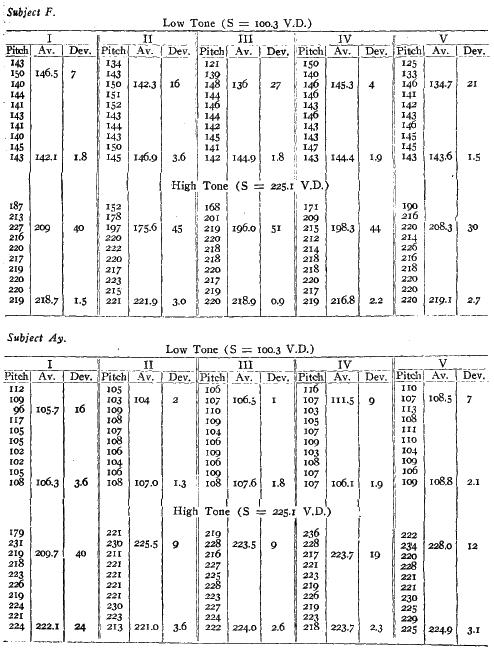
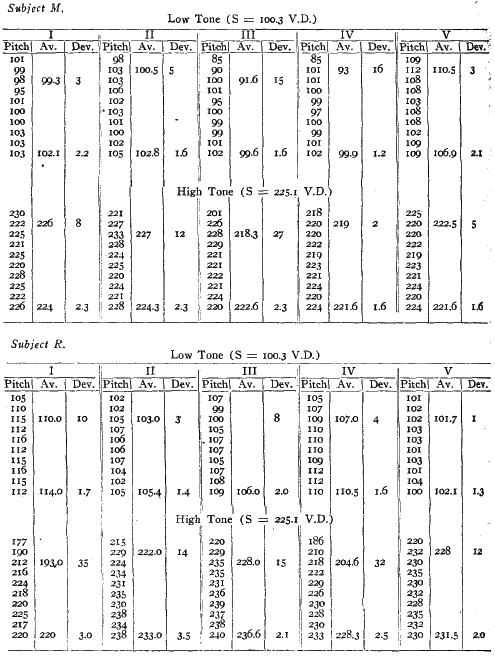
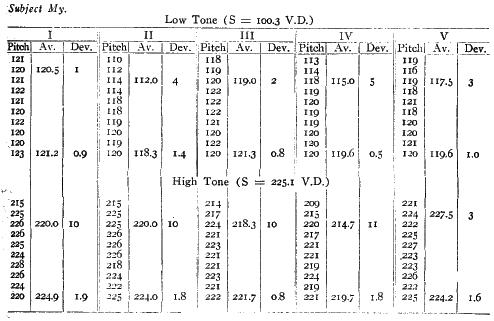
Turning from these general features of Table II to the individual results, it will be seen that all the subjects show much lack of uniformity both in beginning the tones and in continuing them. Roughly, the amount of this lack of uniformity is proportional to the vibration frequency; the variations in the higher tones being much greater than in the lower. Subjects A., F., and My. are not even approximately correct in singing the low tone, but in all other cases there is a fair degree of approximation to the standard. In these cases it seems clear that the difficulty is to be accounted for in large measure by the inability of the singer to distinguish the fundamental tone. Indeed, it would appear from the results that A. and F. are perhaps both responding to a prominent overtone.
In carrying out the practice series of experiments subjects A., F., and Ay. were practiced in the .singing of the low tone. These practice experiments consisted in the singing of the standard in the manner already described twenty times daily for a period extending over several months. In this way a total number of approximately one thousand tones were sung by each subject. M., R., and My. were practiced in a similar manner with the high tone. When the practice period was about half finished the method was somewhat modified. The subjects were now asked to sing the tone while the standard tone was still sounding. At this point in the experiment and, indeed, from near the beginning of the practice series, all the subjects, except A., were approximating the standards. Singing the tone in unison with the standard resulted in some improvement with the other subjects, but A's. record continued to be very irregular and inaccurate.
In A's. case, therefore, a more radical attempt was made to obtain exactness of reproduction of tone. The tone of the standard fork was now made by striking the fork with a rubber hammer and reinforced by an appropriate resonator. Under these conditions A. responded with tones which were more nearly the tone of the standard, but very inconsistently and with no close approximation of the standard tone, although persistent attempts to obtain correct results were made. Before obtaining the final results of singing the standard tones after practice, one hundred practice trials were made in the manner originally adopted-- that is, with a pause between the standard tone and the beginning of the singing. The results of the final series of five tones at both levels for each of the subjects are shown in Table III.
Table III
Singing after practice.
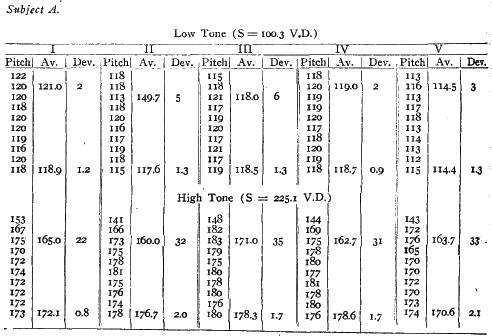
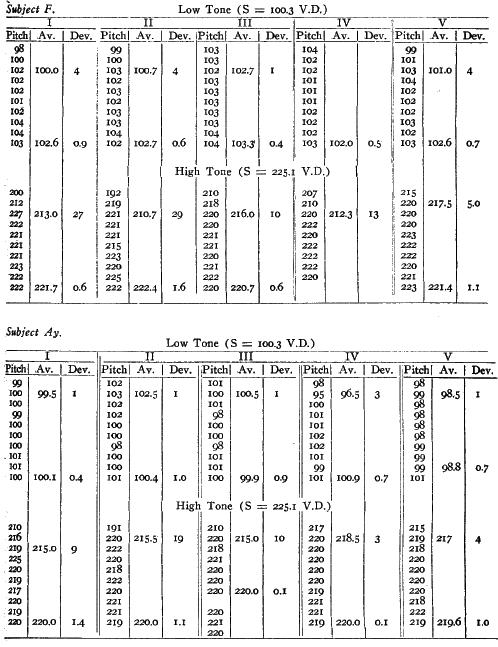
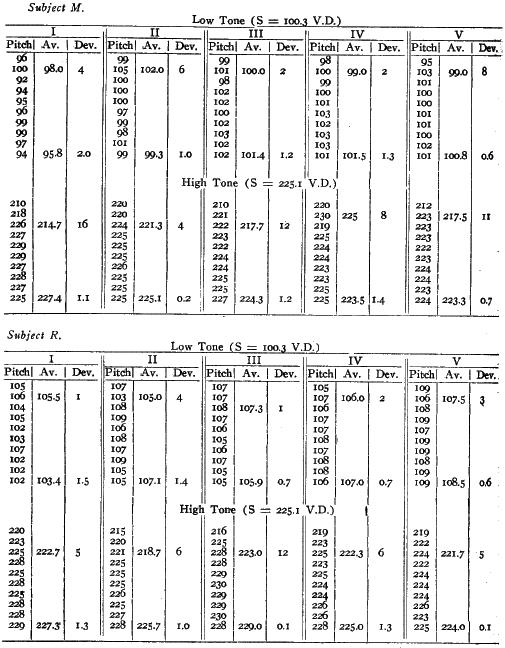
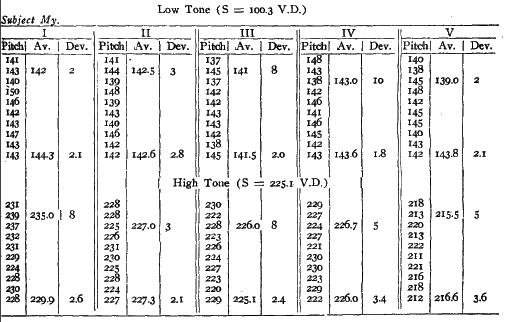
Table IV.
| Subj | Low | High | |||||
| V1 | V2 | V3 | V1 | V2 | V3 | ||
| A | Before | 43.5 | 1.7 | 1.2 | 7.4 | 1.8 | 40.2 |
| After | 17.3 | 1.2 | 3.6 | 49.8 | 1.7 | 30.6 | |
| F | Before | 44.0 | 2.1 | 15 | 6.0 | 2.1 | 42.0 |
| After | 2.3 | 0.6 | 3 | 3.7 | 1.0 | 17.0 | |
| Ay | Before | 6.9 | 2.1 | 7 | 2.0 | 2.8 | 17.8 |
| After | 0.6 | 0.8 | 1.4 | 5.2 | 0.8 | 9.0 | |
| M | Before | 2.4 | 1.8 | 8.4 | 2.3 | 2.2 | 10.8 |
| After | 1.7 | 1.2 | 4.4 | 1.3 | 0.9 | 10.2 | |
| R | Before | 7.3 | 1.6 | 5.2 | 6.8 | 2.6 | 21.6 |
| After | 6.1 | 1.0 | 2.2 | 1.6 | 0.8 | 6.8 | |
| My | Before | 19.7 | 0.9 | 3.0 | 2.2 | 1.6 | 8.8 |
| After | 6.9 | 2.2 | 5.0 | 3.3 | 2.8 | 5.8 | |
For more convenient comparison, the results of Tables II and III are condensed in Table IV. Columns V1 represent the average deviation of the sung tones from the standard before and after practice for both high and low tones. In arriving at these averages the earlier two or three-tenths of a second of the tone were not taken into account since, as we have already seen, they are not representative of the tone as a whole, but of a period of initial adjustment. Columns V2 give the average of the mean variations of the five tones for each subject before and after practice. These figures, therefore, represent the degree of the steadiness of the tone as a whole, disregarding as before the initial period. In columns V3 are arranged the .average of the variations at this initial period for the five high and five low tones before and after practice. The figures of V1 show that A., F., and Ay., who practiced with the low tone, reduced the error in singing at that level. In the case of A., however, the improvement is more apparent than real, for at no time does he approximate the standard. His records from day to day show no gradual improvement as in the case of the other subjects and no constancy of results. The introspective records show that this subject toward the end of the practice series responded in a hit-or-miss fashion with a tone near the lower level of his voice register. When this subject began his practice on any given day with a sung tone of a certain pitch, his subsequent tones were usually of about the same pitch. This tendency to persist in repeating a tone of the same pitch when once begun was found to be characteristic of non-musical subjects in my former study of singing reactions (3) and also in the work of Miles (7). It would appear that such persons in the absence of complete organization of the auditory and vocal motor factors rely mainly upon a memory of the kinaesthetic sensations as cue to further reproductions of the tone.
In the case of F. who began with an error as great as that of A. and in the same direction, a tone was sung on the second day of practice which approximated the standard and improvement thereafter was of a steady character, quite in contrast with the erratic nature of A.'s record. Ay. began with a tone approximating the standard and made steady improvement.
M., R., and My. were practiced in the singing of the high tone. M. and R. made consistent improvement in the amount of error. The figures given for My. seem to indicate a lack of capacity for training with the high tone of a similar nature to that found in the case of A. with the low tone. The similarity, however, does not hold in one respect. My.'s results were, indeed, erratic during the course of practice but he frequently approximated the standard to a much higher degree than did A. This was especially true of that part of the practice series during which the singing took place simultaneously with the sounding of the standard fork. Indeed, it was true of all the subjects except A. that a marked improvement took place during this part of the practice series. In the case of My., however, this improvement was not carried over when the original conditions were restored, while in the other cases it was.
At the end of the practice series, then, F., Ay., M. and R. had made improvement in the singing of tones of the pitch on which they had practiced. At this stage the average errors, respectively, for these subjects amounted to 2.3%, 0.6%, 0.6%, 0.7% of the standards.
Turning now to a consideration of the effects of the practice on the singing of tones at a different level, it will be seen that of those who improved in the practice series F., M. and R. made a slightly smaller amount of error in these non-practiced tones after practice than before practice, while Ay. did worse. There is, therefore, little evidence of transference of practice effects in the accuracy of singing from one pitch to another.
The direction of the error represented by the figures in column V1 is not indicated in the table, these figures being the arithmetical average of errors. A detailed study of this point shows, however, that there is a general tendency to sing the lower tone too high, and the higher tone too low. This statement is unequivocally true of the tones sung by A., F., M. and Ay., both before and after practice. In the case of R. both the low tone and the high were sung too high before and after the practice series. My. always sang the low tone too high but sang the high tone too low before practice and too high after practice. Miles (7) found a general tendency to sharp in male subjects but the fact that his standard tones covered a narrower range within easy compass of his subjects' voices made his results scarcely comparable with our own.
Seashore and Jenner (9) report improvement in accuracy of singing tones after practice with visual control by means of the Seashore tonoscope. In these experiments the improvement apparently transfers to tones of a different pitch from those practiced. That there should be more evidence of transfer under such conditions where the visual control gives a knowledge of results might be expected from other experiments in transfer (4), (6), (8).
A comparison of columns V2 and V3 before and after practice shows improvement in approximation to uniformity of tone both for the tones which were practiced and those which were not in almost all cases. The only exception is in the case of My., all of whose tones were less uniform after practice than before. The improvement with respect to uniformity is not marked in the case of A. and also in the case of M.'s high tones so far as the extreme variations at the beginning of the tone are concerned (V3).
Berlage (1) has found that the deviations from period to period are less when the reproduced tone is sung in response to one's own sung tone than when the standard tone is the sung tone of another person. He also found that the deviations are greater when the tone is sung freely without any attempt to approximate a standard than it is under either of the conditions just mentioned. It seems, therefore, that the steadiness with which a tone is maintained is not a purely physiological phenomenon of muscular tetanus but that it varies with the psychological conditions and is subject to improvement through practice. Furthermore, the effects of practice, so far as steadiness is concerned, are transferred to tones of a different pitch from those practiced, as my present investigation shows. The same statement applies to the larger deviations at the beginning of the tone.
It remains to give the results of the tests for discrimination after the practice series of experiments. These tests were given in the same way as those made before practice. The results are given in Table V and the average results before practice are added for purposes of comparison.
Table V
Discrimination thresholds after practicing.

This table shows that F., Ay., M. and R. have lower thresholds of discrimination at the level at which practice in singing took place than was the case before practice. This improvement is, however, not extended to the other non-practiced level. It will be remembered that these subjects all made unequivocal improvement in the amount of error made in singing their standard tones. In the case of A. and My. no improvement is shown in the pitch discrimination after practice in singing. As has already been shown these subjects made no real progress in the reduction through practice of the error in singing the standard tone.
Comparing tables IV and V it is found that in general the figures expressing sensory discrimination are lower than the corresponding figures for the sung tones. This is true in all but three of the twenty-four pairs of results. In the three cases where this is not true, the figures are practically the same. It would, therefore, appear that fineness of discrimination is more accurate than motor reproduction. This point becomes very marked when it is remembered that the figures given for sensory discrimination are probably much higher than would have been obtained from tests of sensory discrimination given tinder the more standardized threshold conditions.
An inspection of the figures would lead us to expect little correlation between sensory discrimination and accuracy of reproduction for the same tone. Calculated by the Pearson products-moment method the index of correlation is .37 with a probable error of .023. Miles (7) found the index of correlation between accuracy of singing and pitch discrimination for eighty-two male subjects to be only .33. The most marked lack of correlation between accuracy of reproduction and sensory discrimination is in the cases of A. and F., the subjects who made little or no improvement in accuracy of singing but who nevertheless are not noticeably different from the others in the results of the discrimination tests. That practice results in a lowering of the threshold of pitch discrimination has been reported by Seashore (10) and also Smith (11). Seashore distinguishes a so-called "cognitive" threshold from a "physiological" threshold and holds that the cognitive threshold only is subject to improvement through practice. It is clear, however, that the physiological threshold is a somewhat theoretical limit. It must be admitted, however, that the threshold found in this investigation is a "cognitive" threshold found under special conditions. The subjects were required to be certain not only of a difference in pitch but of the direction of the change. While this kind of cognitive threshold, therefore, was peculiarly subject to improvement by practice, it seems nevertheless true that the improvement which actually took place was due to the practice in singing rather than to adaptation, attention, interest, or other factors. Such factors would presumably be operative to as great a degree at the non-practiced level as at the level at which practice took place but, as we have seen, the improvement was not transferred from one level to another, either in the singing or sensory discrimination.
The results of the present study tend to confirm the objections that have been made to those so-called motor theories which regard kinaesthetic sensations as playing the fundamental role in such responses. The results show that motor reactions to tones are by no means so accurate as the sensory discrimination. Judd's study of the eye-movements in the perception of the Müller-Lyer illusion (5) gave analogous results. He found that there was an intimate relationship between the character of the eye movements and the amounts of illusion, and also that both the eye-movements and the amount of illusion changed with practice. Nevertheless, the movements are of such a nature as to preclude the probability that the resultant kinaesthetic sensations are the cause of the illusion.
On the other hand, there is agreement between these results and those of other previous investigations which have shown the closeness of the relationship between sensory and motor processes-- a relationship involving motor organization rather than mere kinaesthetic sensations. In my earlier investigation it was shown that the motor reactions to tones are intimately related to all the forms of harmony and discord. Bingham's investigations (2) have led him to the conclusion that melody is related to the "upsetting of established muscular tensions," "the organization of incipient responses," and the merging of balanced tensions. Stetson (12) has found similar tension-relaxation processes in his experimental study of rhythm. The facts here presented point to the organic unity of motor and sensory factors in even so relatively simple a process as sensory discrimination of tones. With the development of more precise and unvarying modes of response to one tone, there arises a greater keenness in discriminating that tone from all others. Sensory discrimination must, therefore, be regarded as related to the organization which has taken place with reference to the new mode of response.
(1) There is no marked correlation between the initial capacities of the subjects tested for discrimination of tones and ability to reproduce these tones accurately by singing. A subject (A) whose "ear" is little inferior to that of the other subjects is nevertheless totally at a loss to sing the tones accurately.
(2) Practice in singing tones of a certain pitch resulted in marked reduction in the error of reproducing those tones in the case of four of the six subjects.
(3) Slight improvement in singing tones of a pitch different from the one practiced was made by three of those four subjects and no improvement by the other.
(4) Practice resulted in improvement in steadiness both at the initial point of the sung tone and throughout the tone as a whole in the case of those subjects who improved in accuracy.
(5) Improvement in steadiness was also shown in the singing at the non-practiced level.
(6) Subjects who improved in accuracy of singing tones of a certain pitch improved also in discrimination of tones at that level.
(7) There was no improvement for such subjects in the discrimination of tones of a different pitch from that practiced.
(8) Subjects who did not improve in accuracy of singing made no improvement in discrimination.
1. Berlage, F. Der Einfiuss von Artikulation und Gehör beim Nachsingen von Stimmklangen. Psychol. Stud., 1910, 6, 39-140.
2. Bingham, W. V. Studies in melody. Psychol. Rev., Monog. Suppl., 1910, 12, 1-88.
3. Cameron, E. H. Tonal reactions. Psychol. Rev., Monog. Suppl., 1907, 8, 227-300.
4. Judd, C. H. Practice and its effects on the perception of illusions. Psychol. Rev., 1902, 9, 27-39.
5. Judd, C. H. The Müller-Lyer illusion. Psychol. Rev., Monog. Suppl., 1905, 7, 55-81.
6. Judd, C. H. Practice without knowledge of results. Psychol. Rev., Monog. Sup p1., 1905, 7, 185-198.
7. Miles, W. R. Accuracy of the voice in simple pitch singing. Psychol. Rev., Monog. Suppl., 1914, 15, 13-66.
8. Ruediger, W. C. Improvement of mental functions through ideals. Ed. Rev., 1908, 36, 364-371.
9. Seashore, C. E., and Jenner, E. A. Training the voice by the aid of the eye in singing. J. of Ethic. Psychol., 1910, 1, 311-320.
10. Seashore, C. E. The measurement of pitch discrimination: a preliminary report. Psychol. Monog., 1910-11, 13, 21-60.
11. Smith, F.O. The effect of training in pitch discrimination. Psychol. Rev., Monog. Sup p1., 1905, 7, 67-103.
12. Stetson, R. H. A motor theory of rhythm and discrete succession. Psychol. Rev., 1905, 12, 250.